C. Litka's Blog, page 32
April 28, 2023
Launching The Girl on the Kerb (Part 2)

In part one of Launching The Girl on the Kerb, I talked aboutmy decision to launch this title as athriller-espionage/thriller-adventure novel and why it was releasedin a somewhat staggered schedule So how did it fare?
The Amazon paperbackversion was released on 11 March and sold as expected – none,except for the author copies I ordered for myself and my other betareaders. On that same day I also set up the ebook release date for 6April on Amazon.
On 30 March theebook version was released on both Smashwords and Google, and theaudiobook version on Google. Between its release and 5 April it sold57 copies on Smashwords plus 2 ebooks and 7 audiobooks on Google.Though a pale shadow of what sales used to be like upon release onSmashwords, it was neither unexpected or discouraging. Selling books for meis a marathon, not a sprint.
Things shook outdifferently on Amazon, as you can see from a glance at the chartbelow. Amazon decided to match the free price on other stores after only five days,on 11 April. I had no input into that decision, though, of course, Iwelcomed it, readership being my reward for writing. Indeed, untilthree or four years ago I used to email Amazon and point out to themthat my books were free on the other sites and ask that they reducetheir price to match those prices. I stopped doing this since most ofmy books were free, and I didn’t want to rock the boat. Now I letAmazon do as it pleases.
So how exactly did it all shake out? A glance at the chart at the bottom will tell the tale. So what are my takeaways from the experience?
1. First is a given.It is much easier to sell a book for free than at any price, which iswhy I sell my books for free when and where I can. I value readershipover revenue.
2. Concerning thefirst bump in sales after Amazon dropped the price; I think those 274copies through 17 April were more or less organic. Organic in thesense that Amazon wasn’t pushing them, though my wife said that shereceived an email announcing my book. I didn’t. I have somethinglike 215 followers on Amazon, who get notices of a new release.Perhaps many of them picked it up when it was free. That said, Istill have no explanation for why my sales took off as fast as theydid – no other book I have ever released ever sold that many in so short of time, atlease in the last several years. The only difference I can point tois the speed at which Amazon dropped the price and the fact that Ireleased the book in a category other than SF. I have to believe thecategory is significant.
3. The first 274sales were strong enough by 14 April to land my book in the top slot5 on the 100 Best Sellers (Free) list for Thriller-espionage, andnumber 7 in the Thriller-adventure list. Genres seems to matter. I’vehad SF books on the free 100 bestseller list and never seen saleslike this.

4. On April 15 itseems clear that these sales were strong enough to kick in thelegendary Amazon algorithms, the only explanation for the explosionof sales on 15, 16, and 17 April. We’ve often read that you shouldkick start your sales upon release to catch the attention of Amazon’salgorithms which then will pile on and promote sales all on their own– for free. This appears to be the case with The Girl on theKerb.

5. I don’t know ifmy cover helped or hindered sales. It was certainly different fromall the rest of the books on the list – see the screen shot above.However, since all a potential reader sees is the cover before theydecide to click and read the blurb, it certainly played a role, oneway or another.
6. I think this isan exceptional event, and I doubt that it will significantly alter mysales on Amazon going forward, though ideally it will give me some newreaders who will go on and read some of my other books. However, since none of my other books arethrillers, I don’t expect that number to be very large. Time willtell.
7. Even as a onetime event, it’s still three years worth of sales within a month.It’s a gift horse whose teeth I'm not inspecting.
8. My bottom line:it pays, as both a writer and a publisher, to experiment, as I did inthis case with genre category.
As I posted yesterday, Thursday,27 April, marked the eighth anniversary of the release of A Summerin Amber, my first published novel. Next week I will break out mysales numbers for my eight year in publishing, as I have done every year. It was a good year. In fact, the surprising success ofThe Girl on the Kerb was just the icing on the cake. Staytuned.
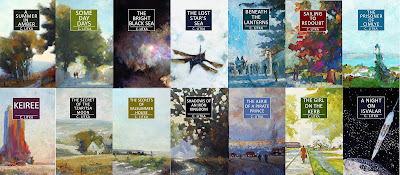
April 27, 2023
Eight Years Ago Today...
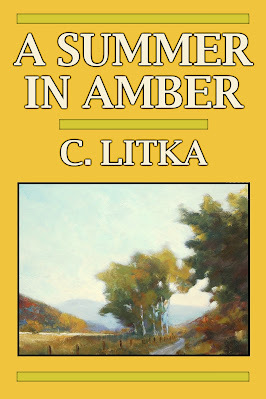
Eight years ago today I released my first book, A Summer in Amber. I had been working on it for three or four years prior to its release, along with the books that would become The Bright Black Sea and Some Day Days. It was inspired, in part, from watching the first two seasons of Downton Abbey on Netflix, with its premise of a romance between a commoner and the daughter of an aristocrat, with a bit of the Scottish stories of John Buchan tossed in. I thought I could do the romance better, and setting an Edwardian story in the future would not only save me a lot of time and grief trying to get Edwardian details right, but I could avoid the inevitable war that would soon follow. Avoiding the real world, while at the same time telling old fashioned stories set in the future, is a pattern I have followed to this day.
It is interesting for me to think back on all the alternative story lines I considered while planning and writing this novel. There were many. My original idea was to make it something of a mystery concerning a scientific discovery by scientists who had taken up residence in the estate during the Storm Years. And then much more of a thriller with the stealing the invention by a ruthless competitor at the heart of the story, but I found that I wasn't a thriller writer. (Or am I? Stay tuned), Instead, I settled on a "what I did over my Summer Vacation" story, and the rest is history.
April 21, 2023
Launching The Girl on the Kerb (Part 1)
 The Cover of a Cozy Thriller
The Cover of a Cozy ThrillerLast week I talked about my new appreciation for my role as thepublisher of my work. This week I am going to continue along thoselines, talking about the launch of my new novel, The Girl on theKerb.
(Edit – I’mnever in any danger of writing anything too briefly. I waffle on andon, and I do so here as well. I had intended this to be a single piece,but after including everything I thought I needed to include to fullyexplain the launching of the Girlon the Kerb, I found the word count approaching 1000 words,and I hadn’t even reached the actual launch yet. It was only thenwhen I decided to split this report into two parts. Seeing that Ihave nothing else in mind to write about, save my April book report,it was an easy decision.)
First, somebackground. By the time March had rolled around, I had learned enoughabout traditional publishing to decide that I didn’t want to sellmy story to a traditional publisher. This was easy to decide, since Ihadn’t been asked. However, the thought of losing effective controlof my work, just stuck in my gullet even though I had no expectationthat Gollancz would actually buy it. Still, I promised myself to waiton their rejection before publishing it myself. It was part of thegame I was playing. They had said that the process would take 6 to 9months, and March was the ninth month… I had only to wait it outbefore I could consider my promise kept.
Nevertheless, Idecided to cheat. Just a little. Given my feelings about traditionalpublishing, I felt safe, on 11 March, to put the ebook version of thestory up for pre-order on Amazon for a 6 April release. Beingslightly superstitious, I always releasing my books on a Thursday,and that was the first Thursday in April. I told myself that I couldcancel the pre-order if the impossible happened and I changed mymind. I then took a step further. Not wishing to wait until mid tolate April for my author copies of the paperback book, I quietlyreleased the paper version of the book on 11 March. Almost no onebuys paper copies of my books, so I figured it hardly counted as arelease.
As it turned out, Ireceived my rejection from Gollancz on the 24th of March.I know of several writers who passed this first process, and hadtheir stories go on to the second round consideration – that wouldtake another three months. Oh, the hoops publishers put poor writersthrough – because they know any writer will do just about anything,and accept just about any deal, to get published.
With nothing holdingme back, I decided to release the Smashwords and Google ebook andaudiobook versions on the following Thursday, 30 March.
My next decision waswhat to release The Girl on the Kerb as. As in what categoryor genre it would be slotted under. Using the freedom andopportunities afforded by being my own publisher, I decided torelease The Girl on the Kerbas something other thana science fiction novel.
There as a number ofreasons for this. The first being that during my time posing as anaspiring traditional writer, I discovered that though I could findagents who said they were willing to take on science fiction, whatthey really seemed to be looking for was fantasy. Indeed, I watchedan interview with an agent who confirmed this, saying that publisherswere far more anxious to find fantasy than SF. That suggested to me that SF wasn't all that hot. And even in author publishing, fantasy outsells SF by a fair amount.
Still, there are a lot of author published SF books on Amazon, but much ofit is military SF in one guise or another. Military SF is the largestsingle category, but when you consider that Space Opera, FirstContact, Alien Invasion, as well as Adventure all usually featurewars of some sort, that’s more than half of the SF titles. Thissuggests that military SF in its various guises is what most AmazonSF fans want to read. Since my story isn’t military SF, releasingit as SF would mean that it would likely only appeal to my usualreaders. Which is fine… But if I could find some way to find somemore readers...
A second reason fornot releasing it as SF is that over the last couple of years I’vehad my own personal epiphany. I’ve had to admit to myself thatdespite considering myself a SF fan almost all my life, after readingSF blogs and watching SF YouTube videos, I've come to realize that I really don’t like mostSF stories. On any list of 100 great SF books, I may’ve read, ortried to read, 17 of them. Of course, I’ve slotted almost all of mybooks into SF, because they are all set in the future, and most onother planets. But that, in part, is due to sheer laziness on my part; itmeans that I don’t have to do the research needed to write a storyin real places at real times, I could just make up things as I goalong. But thinking about it, is the setting what really matters? What if Ireleased it in accordance to its plot rather than its setting?
If I wanted to findnew readers, and as a publisher, I do, it seemed to me that I wouldhave to offer something new to find new readers. I had tried thisbefore, writing and releasing Beneath the Lanterns as fantasy without, I must admit, any great success in breaking into the fantasy market. However, I’m hoping to rectify that this year… butthat’s a subject for another post. Still, I had to believe that it was worth trying again. In this case, I decidedto release The Girl on the Kerb based on its plot, by listingit as an espionage novel instead of a SF novel. I figured I could dothis, just as long as I made it clear in the blurb that the story wasset in the far future, i.e. they were getting an espionage novel witha SF twist.
Having decided onthis course of action, I discovered, when setting up the book, thatespionage novels are not a separate category. Rather, they are asub-category of “thrillers”. This, I must admit, gave me a bit ofa pause. I hadn’t written a thriller. Or at least, I didn’t thinkI had. Though not being a reader of thrillers, I couldn’t say oneway or another. Perhaps there are such things as “cozy thrillers.”Well, if not, I guess I’ve gone and invented them with The Girlon the Kerb. In any event, I decided to go with “Thriller –espionage” and double down with “Thriller – adventure” forits category/genre. No mention of SF at all. Nothing ventured,nothing gained.
So how has it gone?That’s next week’s subject. Stay tuned.
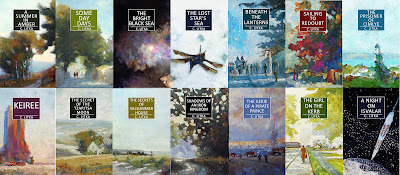
April 14, 2023
Omnibus Editions
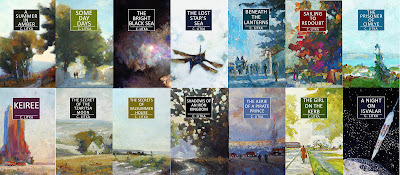
I find the publishing business, both traditional and independent, tobe interesting. Since I've been paying more attention to traditionalpublishing lately, I’ve come away with one important takeaway. I nowconsider myself an author/publisher rather than a self-publishingauthor, or an indie-publisher. I write stories. I publish stories.They are two jobs. I do them both. And except for scale, mypublishing business is not all that much different from whattraditional publishers do, save that I care lot more about the booksI publish than most traditional publishers do for most of their books these days.
I’ve been apublisher for eight years. My publishing business model is prettyunique, in that it prioritize sales over revenue, fun over work,and yet makes a very small profit every year. I've alwlays been looking for waysto improve sales – efforts that traditional publishers don’tbother with. I have updated all my books many times to correcterrors. I’ve revised the text a little in some of my books to improve them. I’ve released all my books with different covers. I have tried differentprices as well. And I’ve tried new technology, like audiobooks,when I had the chance. I haven’t tried going allin with Amazon, and I don’t plan on trying that.
But what I haven’tdone so far is to focus any efforts on my Amazon offerings outside ofthe U.S., where by and large, Amazon does not price match my freebooks. This summer I plan to address that oversight by offering omnibus editions of my books at special prices exclusively on Amazon. In the U.S. where most of my books are free on Amazon, this won't be a big deal, but for foreign sales, it will allow me to offer my books at discount prices, without changing the list price of my current offerings. Not that it would matter, save that I set the list price as a mark of quality with the price then discounted on Amazon.
To begin, this May I plan onreleasing an omnibus edition of my four book Nine Star NebulaMystery/Adventure series, priced at $.99 for the first month or two before raising it to $2.99. This omnibus version will actually work acrossall the Amazon stores, since two of the books in the series are stillat list price of $2,99 in the U.S. store, so the $.99 or even $2.99price will still be a deal in the U.S. store.
After that, I willcreate a Lost Star Stories Omnibus edition that includes bothThe Bright Black Sea and The Lost Star’s Sea. I hopeto price it at $.99 for the first month, but I think that Amazonmight have some limits on the word count for $.99 books, so we’llhave to see how that goes. It too will go up to $2.99 after the firstmonth or two.
Next up will be my two near future books, A Summer in Amber, and SomeDay Days, packaged as a Before and After the Solar StormsOmnibus. Since I’m currently writing a third and final TropicSea story, I’ll let that omnibus version slide until 2024 when itwill be complete. Finally, late this fall, my Post Solar AgeOmnibus, including Keiree,Under the Lanterns, and The Girl on the Kerb willbe released.
I don’t expect this program to generate a lot of revenue. However, more than half of my sales on the other platforms come from outside the U.S., so that offering editions of my books at very special prices might move the needle a little on Amazon as well. Or not. We'll see. "We'll see" seems to be the moto of the publishing business.
April 11, 2023
The Girl on the Kerb is now FREE on Amazon

Amazon, all on its own, has reduced the price to The Girl on the Kerb to FREE, matching its price everywhere else - without me asking them to. Price changes like this on Amazon are out of my control, so pick up your copy now, while the getting's good.
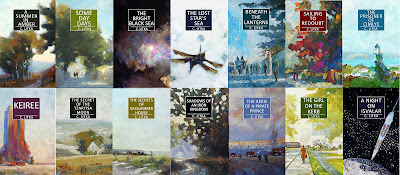
April 7, 2023
Books I read in March
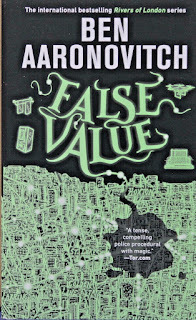
False Value Rivers of London Book 8 Ben Aaronovich B-
Gosh, anotherfantasy book. That said, I have been reading the Rivers of Londonseries since it first came out, a decade ago or so. I did, howeverfall behind for a time, as there was a time when there were no massmarket paperbacks to buy. I think that now I have read all the novelsup to this point. I know that I have not read the short stories.
The highlights ofthese urban fantasy books set, you guessed it, mostly in London, isAaronovich’s writing and first person point of view character,Peter Grant, a London policeman with magical powers. In additionthere are a cast of strange and wonderful characters, includinggoddess tied to the rivers that converge on the Thames in London. Thestories are set in our world, where magic exists, but is rare enoughthat most people are not aware of it.
This story is abouta secretive high-tech company developing an artificial intelligence,that already seems dated in 2023, with the advent of AI chat and artbots. As usual, I won’t go into the plot, except to say that it isconvulsed, and deliberately so. The first part of the story’s timeline is sliced and diced, telling the story out of chronologicalorder for no discernible reason that I can discover. Indeed, I haveno idea how long the story spans. And Aaronovich throws in a lot ofsub-plots, minor characters, and police procedural details that servemore to bump up the word count than advance the story. All of thisaccounts for the “-” behind the “B” rating, so you can seethat they were minor annoyances, especially the out of chronologicalorder telling of the story, and I still enjoyed the story despitethem. It was a better story than the one the proceeded it.
My other generalcomplaint is that the premise is that magic is so rare that it isunnoticed in our world, save for a small group of people. However, asthe series continues, magic plays such a large role in large scaleevents in these books, that it is unrealistic to expect me, at least,to believe that this is our world. If magic exists in our world, itis rare and known to an actual few, not the entire London policedepartment. I had the same complaint for the book I read last month,Fated. You can’t have it both ways; our familiar world with magicall but unknown, or a world were the existence of magic is widelyknow and as a result, the world would be very different. But that’sno doubt the writer in my outlook.
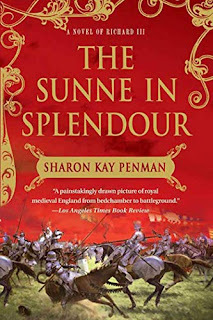
The Sunne inSplendour Sharon Kay Penman DNF 7% (page 71)
No doubt a perfectlyfine book, but not for me. I was looking for some historical fiction,and this one sounded pretty good. It’s about Richard III and theWar of the Roses. However, this book starts out with Richard as achild of seven, and to be perfectly honest, I am not interested inreading about children, unless I am reading to children. In this wayit covers history leading up to when Richard steps onto the world’sstage, but with 1233 pages, it clearly was going to take a while toget there.
My other complaintis my usual one – hopping between point of view characters. In whatI read of the story, we start with young Richard, move on to one ofhis older brothers, and after he is killed, on to Richard’s mother,at which point I called it a day.
My objection tojumping around in the heads of characters in general, is very simple:in my view, it makes them props rather than characters. Authors use them, and their thoughts, to tell what they want at any point inthe story, and when whey don't need them, they are just ciphers,pawns to move around. In these types of stories, the author is themain character, as they are the ones who play every role, jumpingform character to character, to speak every important line, thinkevery important thought. I want to be told a story by a person, aboutpeople, not sock puppets. Readers can get to know characters fromwhat the say and do, we don’t need to be in their head to knowthem. And not, when the author doesn’t want us to know what theyare thinking for whatever reason.
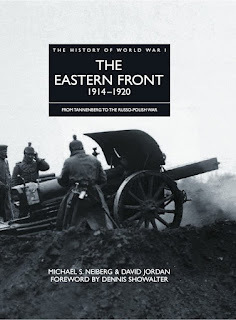
The Eastern Front1914 – 1920 By Michael S Neiberg & David Jordan B-
This is an overviewof World War One and the Russian Revolution, part of a series: “TheHistory of World War One.” As such is is a perfectly fine, wellwritten book. It includes maps and lots of photos, with many sidebarson different aspects of the war on the Eastern Front and thepersonalities involved in it. As I mentioned in my Waterloo Bookreview, military history without easy access to maps, is less thanideal. Here the maps were pretty general, and not adjacent to thetext, but that is the price you pay if you are too lazy to go outinto the cold and drive to the library for a paper book. As well asWorld War One, it covers the battles of the White Russians againstthe Bolsheviks, and briefly, the war between Poland and Russia. Theselater conflicts were very confusing in reality, and they remainconfusing in the book as well. Still, the book does the job it setout to do; give the reader an overview of World War One beyond thetrenches of the Western Front.
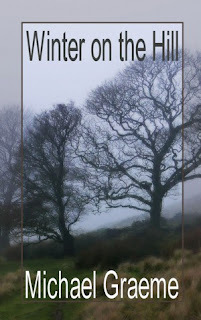
Winter on theHill by Michael Graeme C
Graeme writesintrospective novels of literary fiction. All three of the novelsI’ve read so far, are narrated by men of a certain age – ofsixty, plus or minus a few years – who find themselves inretirement a stranger in a strange land. They are single, lonely,usually rather bitter, if not angry, about not only their lives, butwhat has happened to the world in their lifetime. They are lookingfor something worthwhile to do with their rather empty lives. Withinthis narrative of contemplation, Graeme introduces characters thatchange the lives of his narrator. In this novel, it is a set ofmostly single women of a certain age who are members of a hiking clubthat he joins. Set in the Covid years in Britain, the story revolvesaround his relationships with several of those women, one of whom hastaken a vow of silence, and thus is very intriguing. It is very mucha slice of life story, not much of a romance, and in the end, not allthat satisfying of a story, as the key character, the woman whodoesn’t speak, doesn’t quite live up to her potential as acharacter, I think. We never quite get to know her, even as thenarrator spends more time with her. Maybe it’s just me, I likeromances, but unlike the first two Graeme books, Saving Grace,and the best of his that I’ve read, A Lone Tree Falls, havea strong genre mystery story that is wrapped within all the thoughtsof his introspective narrator. That strong mystery/genre story ismissing in this novel despite his attempts to suggest one. It ismostly introspective thoughts, and those get rather tedious.
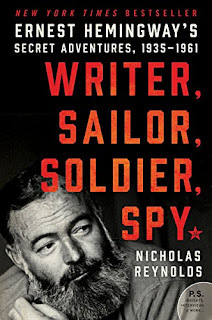
Writer, Sailor,Soldier, Spy Ernest Hemingway’s Secret Adventures 1935-1961 byNicolas Reynolds C
Non fiction. Thiscovers Hemingway’s life from about 1936 to his death in 1961 andfocuses on his ongoing fight against fascism, first in Spain and thenin World War 2. And documents his contacts and general approval ofthe Russians who were the only ones who were fighting fascists.Though he was never a formal agent of the communists, he had files inboth Moscow and Washington as a know lefty. It is a very detailedaccount of what he did and who he did it with reporting andoccasionally fighting in both Spain during their civil war, and thenin World War 2, where he used is fishing boat to patrol the watersoff of Cuba in order to locate German submarines, and then, landingwith the US Army’s Normandy invasion, and followed it on to theliberation of Paris. I found all of the details and characters a bit tedious, but that’s just me.
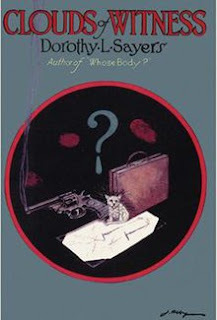
Clouds of Witness by Dorothy L Sayers C
My reading chair isalongside my wall of books. And the books most handy from the readingchair is my modest mystery story collection. This is a Lord PeterWimsey mystery. It has no doubt been on my bookshelves for half acentury. I may’ve read it back in the day. Or not. I seem toremember that I grew rather weary of Lord Peter Wimsey bright banter.In any case, I had no recollection of it, nor did reading it stir upany. In this book, Wimsey’s older brother is charged with murderand Wimsey must discover who actually did it, despite the silence ofhis brother. Sayers writes an intricate mystery, but I found itrather slow going, and never got caught up in the story or themystery. And there were several scenes that I though were a bit overthe top. I have several more Wimsey books on the shelf, but I won’tbe getting to them anytime soon.

The High Windowby Raymond Chandler A
I reached over andpicked up another mystery, and this was the one I picked up. RaymondChandler and P G Wodehouse where the two authors that I discovered inmy early 20’s that changed the way I looked on reading. After adecade of reading SF where stories, if not just far out ideas, werethe focus, I discovered that with Chandler and Wodehouse, writingbecame the focus. Never mind the story, their writing alone was theentertainment. It still is. If you like clever, witty, gritty, andmarvelously atmospheric writing, with deftly drawn characters andconvoluted plots, Chandler is your guy.
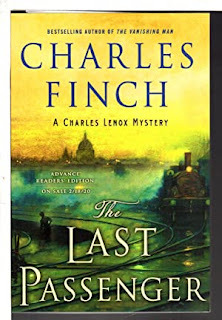
The LastPassenger - A Charles Lerox Mystery by Charles Finch C-
This is more or lessa cozy mystery set in London in 1855. It is the third prequel to along running series of Charles Lenox mysteries. It recounts how helearned his trade and lost his love. I found it to be an annoy book.It is written by an American in a contemporary style for acontemporary audience, and as such has almost no authentic feel. Abunch of Victorian era tropes are thrown in but from such a remote,modern distance, that they add no atmosphere to the story. In thisbook Finch was either trying to showcase his Wikipedia skills, oreducate his readers, since he tosses in all sorts of factoids intothe narrative. Things like brief bios of a historical characters, thehistory of the anti-slave movement in Britain, why the tobacco plantwas introduced in Europe, etc. None of which are necessary for thestory. But what bugged me the most was that he didn’t get the factsright that he shoved into the story.
The story involvesfind a mutilated body on a London and North Western Railroad traincarriage from Manchester in Paddington Station. He has his hero usehorse drawn dog carts to search along the track from PaddingtonStation, explaining that “the width between railroad tracks allacross England was exactly four feet eight and a half inches…because that was the width of a horse-drawn wagon.” and goes on toexplain how that came to be, adding at no extra cost, that was alsothe exact width for the war chariots of ancient Rome. Finch then hasus to believe that not only could a horse-drawn dog cart be pulledalong the top of the two rails without the wheels slipping off at anyspeed, but that they could do so without making any specialarrangements on two rail lines leading from Paddington Station –without being run over by approaching or departing trains. Even in1855 a station like Paddinton would have trains arriving anddeparting on numerous tracks. However, leaving that impossibilityaside, if Mr Finch had done his Wikipedia homework thoroughly, hewould’ve discovered that in 1855 the width of railroad tracks wasnot uniform across England. The Great Western Railroad operated onit’s own wide gauge tracks, those being a seven foot and onequarter inch gauge (I looked it up on Wikipedia). He would have alsodiscovered that the London terminal for the GWR was PaddingtonStation. If he had looked a little further into the Wikipedia entryfor the London and North Western Railroad, the train arriving inLondon from Manchester, he would have discovered it would havearrived in London at Euston Station, the L.A.N.W.’s Londonterminus. So why Paddington Station rather than Euston? I’ve noclue. A minor point, yes, but if you are going to stuff your storywith all sorts of extraneous “facts,” get them right.
I will not becontinuing on with this series.
March 31, 2023
The Girl on the Kerb is Finally Available!

My 2023 full length novel, The Girl on the Kerb, is now available! Get your copy in the your preferred format today at the following online bookshops!
EBOOK
Smashwords: Here For FREE
Google Play Store: Here For FREE
AUDIOBOOK
Google Play Store: Here For FREE
TRADE PAPERBACK
Amazon: Here For $11.99
Amazon ebook version will be released on 6 April 2023 Here It can be pre-ordered now for $3.99 Amazon requires a non-zero price. They may reduce the price to match the other stores at some point. Or not. It is up to them.
Apple, Kobo, and B & N ebook versions will become available within this next week once the book clears Smashwords premium process. All these versions will also be FREE.
The Girl on the Kerb
"Thered 8:25 tram crossed Crane House Lane and disappeared behindVilliers House, sealing my fate. I’d be late for work. I slowed toa walk and took another bite of toast. I found I didn’t care. Itwas that kind of day."
– HenriHardy, The Girl on the Kerb
Ittook several months for Henri Hardy to discover just what type of dayit really was. It was more than a day when his alarm clock failed toring. It was more than an unusually mild day in early spring. It wasa prelude to undreamed of changes in his life as an analyticalengineer in the Ministry of Innovation. It was a prelude to travel,adventure, danger, and romance.
Fifteenhundred years before that day, a devastating plague swept across theplanets, moons, and space ships of Earth’s solar system spanningcivilization. It ended space travel and forced the survivingpopulation of the resource depleted Earth to live at a near 20thcentury level of technology, while endlessly recycling theremains of their once highly advanced civilization. To that end,every aspect of their society is governed by an elaborate set of lawsknown as the Code.
Butnot everyone is content to live at the reduced level of technologydictated by the Code. There are those who dream of returning to spaceand the planets. Once such person is the administrator of Europe’sEuraEast region, the Duchess of Fauconcourt. She has made it clearthat she intends to alter the Code, one way or another, much to thealarm of the neighboring regions’ administrators. So when anillegal flying machine that crashes in EuraEast comes to theattention of the administrators of EuraCentre and EuraNorthwest, theyrecruit two amateur agents. One being Henri Hardy, the other isJeanne Murat, an expert in EuraEast. Together they set out as a teamfor EuraEast seeking the evidence needed to compel the WorldGovernment to preemptively act to foil the Duchess’ dangerousambitions. Murat and Hardy soon discover that not only had theirgovernments selected them as a team, fate had as well.
Nevertheless,their mission to EuraEast goes south almost immediately, propellingthem into one perilous situation after another, even as they seek touncover the Duchess’ secret plans.
TheGirl on the Kerb isa new full length novel from the pen of C. Litka. It blends a farfuture world with a nostalgic past in an espionage novel filled withintrigue, adventure, and romance, told in his classic lightheartedstyle. Like all his novels, it features engaging characters, wittydialog, meticulous world-building, and mysteries to be solved inunexpected ways.
C.Litka’s novella Keiree is set on Mars after this same plagueand in this same time period, so that The Girl on the Kerb canbe read, not as a sequel, but as a companion piece to that story,answering the question of what happened on Earth. And vice versa.
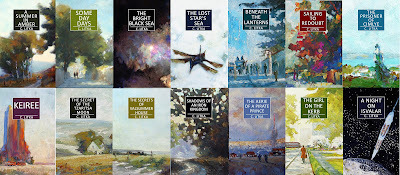
March 26, 2023
The Girl on the Kerb - Smashwords & Google Release Date: 30 March 2023
 The iconic "WTF? This is a SF cover?" cover
The iconic "WTF? This is a SF cover?" coverI received an email from Gollancz on Friday indicating that they were passing on the novel I had submitted to them, which eliminated any lingering considerations that I might have had about publishing it myself. I had none, Nevertheless… this allows me to release The Girl on the Kerb a week earlier on Smashwords and Google, which is to say on 30 March 2023!n It will be FREE, as usual everywhere but Amazon.
This earlier release will allow the book to work its way through Smashword’s premium service so as to be available everywhere by 6 April when the ebook becomes available on Amazon.
The trade paperback version is already available on Amazon for $11.99
The FREE ebook version of The Girl on the Kerb will be available on Smashwords & Google on Thursday, 30 March 2023 Apple, Kobo, B & N versions should follow within a week.
The FREE audiobook version of The Girl on the Kerb should also be available on 30 March 2023 on the Google Play Store Books/Audiobooks
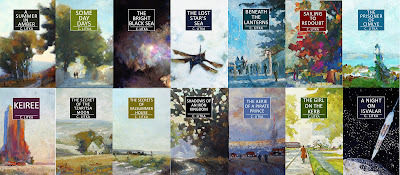
March 24, 2023
March Writing Update
 There might still be room for one more book...
There might still be room for one more book...So what comes after the looming release of my 2023 novel, The Girl on the Kerb on 6 April 2023, you ask. At least for the purposes of this post, you’re asking.
First off, I’m hoping to enter my one “fantasy novel,” Beneath the Lanterns, in the Self Published Fantasy Blog Off this May. I wanted to do so last year but somehow missed the very brief entry window. I am determined to keep on top of Mark Lawrence's blog so as to not miss it this time. With that in mind, there were several minor things in the book that sort of bugged me about it, so, with nothing more pressing to do, I spent a week reading it over and making some minor changes.
I started with rewriting the opening paragraph, which struck me as rather clunky. Next I felt that the story had gotten a little dated, even after only five years. In the story the daughter of the Empress of Jasmyne is sent to marry the son of the leader of the Azere Empire in an arranged political marriage. This daughter shows up looking like a boy and dressed as a soldier which enrages the groom’s father. I wanted to make it clear that it wasn’t her appearance per se – or what it implied about her sexual orientation – but rather that it seemed to be an act calculated to suggest that if the two leaders were expecting grandchildren – who would have claims to both thrones – they would find themselves disappointed. It is this implied threat that angered the Azerian ruler rather than how, or what she appeared to be. That, and the possibility that he had been tricked into accepting her by the Jasmyne Empress. Beyond that, I fixed sentences here and there that had even me confused when I came upon them. All in all these changes added about two pages to the book, hopefully making it just a little more polished, just a little better.
As for new work… I have pretty much let the winter slide by without working on anything new. I did some work on the third and likely final Tropic Sea book, Passage to Jarpara back in January, adding several new chapters at the beginning of the story I had started last fall. However, upon reaching the parts I had previously written, I lost interest and so far have not continue on. Still, I have some 38,000 words written in first draft that I can return to whenever, if ever, I get in the mood to write again. Right now I’m considering it my 2024 novel so there’s no hurry to finish it. I’ve got 18 months… But who knows? I must confess that with eleven novels and three novellas written in the last dozen years I don’t feel any great urgency. I’m content to let them can stand as my legacy. Still, it has been a habit of a decade or more to spend an hour or two every day writing, so I may well find that I have nothing better to do than to continue to plug away on that story.
As an alternative, I’ve been entertaining the idea of a sort of portal fantasy novella, writing it off and on in my head. However, I am not satisfied with my initial version – it offers nothing new at all and seemed almost too close to Zelazny’s Nine Princes in Amber'spremise, though far less elaborate, of course. If you are going to write something, it should bring something new to the table, which I haven’t found yet. I am not very optimistic about finding that new thing, but I'm still thinking about it.
Looking ahead to summer, I’m planning to play with my back catalog. Once the initial jump in sales that a new book brings, I will release a “boxed set” of my four Nine Star Nebula stories on Amazon. Several of them are not free on Amazon.com and none are free on Amazon’s other stores, as far as I know, so that a boxed set – at a sale price – might lead to some sales. If that generates any interest, an omnibus version of my two Lost Star books might follow as well as boxed set of Some Day Days and A Summer in Amber all aimed at the non-US Amazon market, were most of my books are not free.
To summon things up; if I should find something new in the portal fantasy novella idea, it might see the light of publication this fall. If not, then Passage to Jarpara sometime in 2024 might be my next work. But again, it’s not something I would bet money on
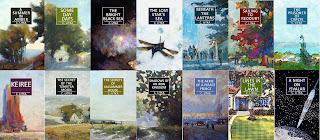 Looks like I'm going to have to update this image
Looks like I'm going to have to update this image
March 17, 2023
The Making of a Cover, Part Three

Let’s address the elephant in the room. This is a silly painting for a book cover, especially one for a story that purports to be an espionage & science fiction adventure story. What gives?
What gives is that this is an expression of the great joy of writing and publishing your own work. You can do whatever you damn well please. The painting illustrates, with some artistic license, the opening lines of the book. And the opening lines of the book are me thumbing my nose at the received wisdom of what an opening line should be these days in a traditionally published novel. The fashion in books today is to have a opening “hook” to draw the agent, editor, and eventually, the reader into the story, like a fish. The opening should have a worm, a barbed hook, or intriguing lure. Of course you still have to land the fish, but let’s leave this analogy aside, and move on…
One of the many things that bug me about today's fashion in books, is the perceived necessity of hooking a reader with a dramatic, and often violent, opening scene. Sometimes this is in the form of a prologue, sometime this is a scene taken from the middle of the book that then has to be then walked back. and sometimes a writer just starts their book in the middle of the action and explains it later. The idea is to raise the stakes in order to draw in the reader. I’m not saying that it doesn’t work, only that it doesn’t work for me. In the case of The Girl on the Kerb, I deliberately decided to make my opening stakes trivial, by having my main character oversleeping and finding that he is going to be late for work. Basically, it's a private joke, but I write what amuses me, so it works, for me. And I’m willing to let the chips fall where they might.
The cover is in the same vein. There are more than a few exciting scenes in the story, but the overall tone of the book is similar to all my others; lighthearted and very retro, despite it being set in the far distant future. The cover is about as far away from science fiction as you can get, and this is somewhat deliberate, as I will be "marketing" this as an espionage novel first, SF second. While my regular readers are used to my covers, who knows how this cover will be perceived by readers not familiar with my work. My theory is that my covers, being different than the run of the mill books in the genres, makes the WTF nature of it stand out as something different, something worth investigating. That's my story, anyways. On to the cover.
Below is the original piece of art I painted for the cover. I take these photos of the art outside, and as a result the photo captures some of the blue of the sky, which usually gives the resulting photo of the piece of art a blue cast that has to be color corrected. The photo below is before I corrected for color, so the blues are bluer in the photo than they are on the paper.
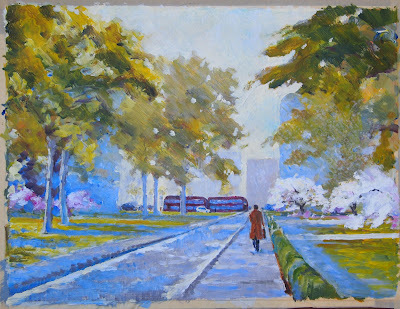
As I mentioned in my last post about this cover, the painting is just the first step. After I take a photo of it and upload it into Gimp, where I can play around with it, changing tone, colors, crop and edit details. Below are the various versions I tried. In them you can see how I played around with color, tone, size and orientation it order to capture the mood I wanted to give to the cover - that of a carefree spring morning.

In this first attempt, above, I've brightened the painting, toned down the blues and upped the yellows to create a bright spring morning look. I faded the colors of the tram and distant buildings in the distance to create a greater sense of distance. And finally, I added the cartoon effect to sharpen everything up a bit.

In the next version above, I dialed back the brightness of the yellows, did not fade the distance, and upped the blues a bit. The cover is cropped slightly different as well. Things like this come down to a matter of taste and experimentation. It works pretty well, but I was afraid that the printed version would be too dark and dull.

In the version above I've brightened things up again, making the colors more saturated, in anticipation of the colors getting duller when printed on a matte cover. The distant buildings are a bit more faded, the tram less so. Plus, the crop is different, making the figure of Henri Hardy a little larger.

In the above version I've died back the brightness a bit and enhanced the blue in the shadows. The black outlines are a little stronger. The crop is a little wider so the character is a little smaller.

In this, the current final version of the art, I've once again dialed back the blues, and the black outlines. I have fixed up the tram so that it has more regular features and straightened it roofline a bit. The crop is closer, so the figure is larger again.
As you can see, these are minor variations, each has its pluses and minuses. It's take your pick. And one of the factors in taking your pick, is knowing that what you see on your computer screen is not exactly what your printed copy will look like, even if you have a color calibrated screen, which I don't. Images often look darker when I open an image in another context like the Amazon listing, so I'm not afraid to make my images pretty bright, confident that they won't be too bright at the end of the process. In addition to the image on a glowing screen is going to look different on a matte paper book cover. And those covers might be a little different every time the book is run. Being print on demand books, subtle differences in color can occur. For some reason my dozen author copies of my most recent release were printed at two different plants, and there was a slight difference in colors between the two editions. The nice thing about self publishing is that you can tweak things as you go, even paperback covers, since there is no long press run. (I saw a YouTube video recently where the cover had an error in it, a quote from H P Lovecraft, without the quote, so they had to place a sticker with the quote above his name on the cover. Having been in the print and newspaper industry, things like that happen. Somehow.)
If you look closely at the actual cover of the printed book above and compare it to the final version on the top of the page, you will see that I've tweaked the back blurb a bit. Not that it matters, since I do not expect anyone to find this book in a bookstore and turn it over to read what the story is about. The back blurb is there, just because that is how things are done in the real world.
Not being a patient fellow, and not wanting to wait 2 to 3 weeks after my announced release date for my author copies of the books to arrive, The Girl on the Kerb trade paperback is now, quietly, available for $11.99 on Amazon ( Here ) in order to get my copies as soon as possible, hopefully next week. My beta readers will get their copies a week or so after that. You, dear reader, are welcome to get you own paper copy now.



